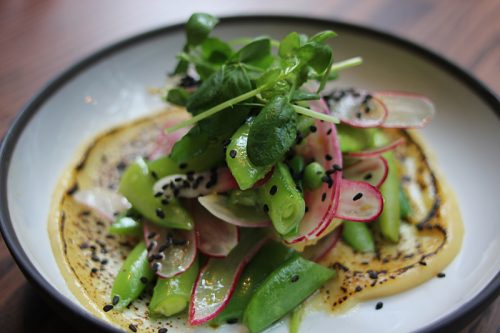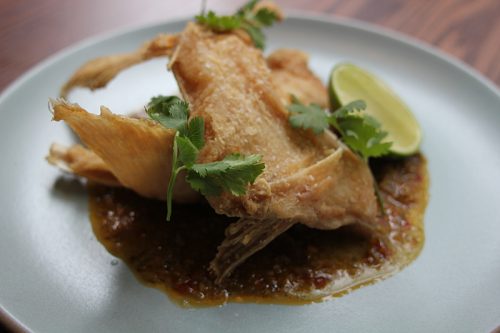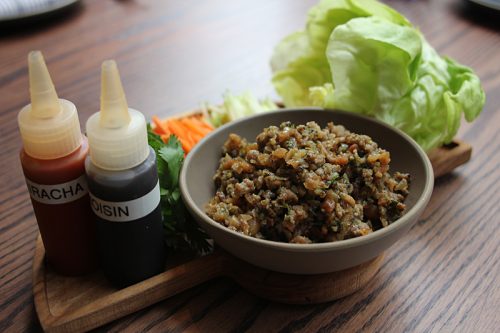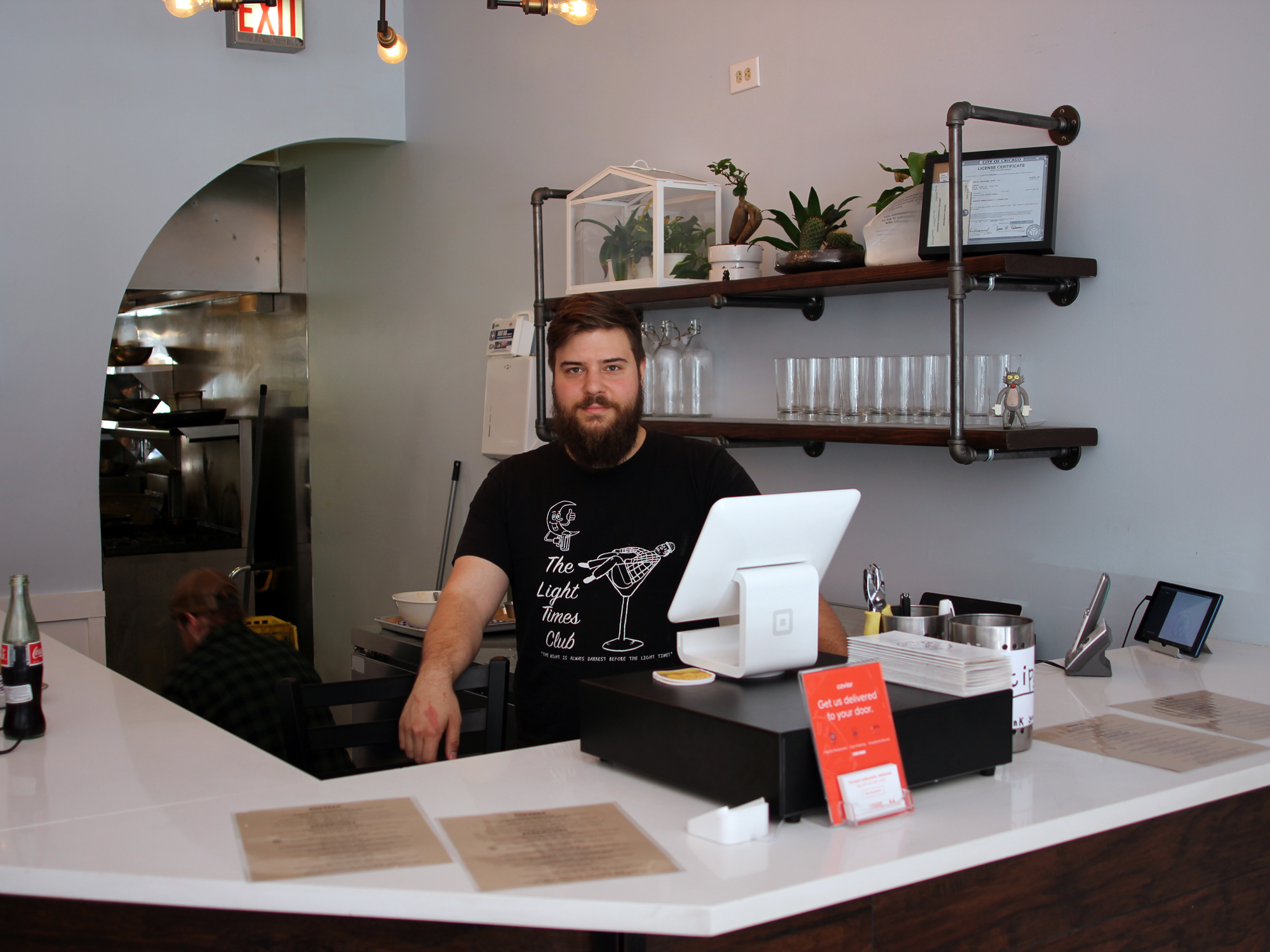AS WE’RE GETTING READY TO SHOOT A FEW DISHES at Proxi, the new upscale street food restaurant from Sepia owner Emmanuel Nony and Sepia chef Andrew Zimmerman, Zimmerman offers me a bright orange bag of some kind of snack with cartoonish Korean letters on it. “Have some cheesy pasta snacks from Joong Boo Market,” he says. There was an ingredient he was lacking, and the easiest way to get it was to swing by the rambling Korean market, tucked next to the expressway on Kimball, and so he picked up a bag of something unusual to munch on for his staff. (They’re pretty tasty—probably due to a frightening amount of MSG.)
I suspect Zimmerman was also amused by the Korean caricature of a white American chef on the bag, which kind of looks like Chef Good Ol’ Boy-ar-dee. It’s a self-mocking symbol for what’s happening at Proxi, which is that a chef who has run a very high caliber business lunch and dinner place for the last half dozen years—which earned him a James Beard Awards nomination for Best Chef Great Lakes five years running from 2012-2016, not to mention a Michelin star since 2011—is now making a lot of Asian food.
Why is he doing that? Because he loves it, and because he lives in a city where you can experience so much of it (and run out to an Asian market when you need something). He also works in a time when so much of his audience also loves it, and knows it well enough that the people who eat Sepia’s impeccable modern cuisine will also be happy to eat something funky and spicy. (And that is crafted with the precision of Sepia’s kitchen—read this Grub Street interview I did with him years ago for a sense of how tight a ship Zimmerman runs, and why Michelin and the Beards have recognized that fact.)

Chef Andrew Zimmerman
I called Proxi an upscale street food restaurant, but if that descriptor calls up, say, small and hipster Mott Street in Bucktown, well, we’re in a whole different class of street food restaurant now. Located in the West Loop just two doors north of Sepia and open for about three weeks now, Proxi has a big, glamorous interior, the kind of chic black and white and gray space where you would expect to find steak, or at most dressy Italian food. It gives off see and be seen vibes, and if crowds can be seen here while eating Thai and Vietnamese and Indian flavors, it’s the latest sign of how fine dining continues to evolve in Asian directions (as discussed here at Fooditor). I asked Zimmerman how Proxi came about.
FOODITOR: How did you and Emmanuel decide that you wanted to open this as your second restaurant?
ANDREW ZIMMERMAN: We started talking about it about 2-1/2 years into my working at Sepia. Just sort of loosely discussing, if we were going to do another restaurant, what kind of restaurant it would be. Emmanuel spent a lot of time working in Asia, in Japan and Hong Kong and South Korea. I’ve been around, but never to India or Southeast Asia, unfortunately.
The first things we talked about were more kind of specific things—like, maybe we would want to do an izakaya, because of his time in Japan, and I’ve been to Japan, and I really like Japanese food. But for one reason or another, that didn’t feel like quite the right thing for us to do. There were various other permutations—it was hard to totally dismiss the idea of doing a restaurant based on some kind of French food. Probably not a fine dining French restaurant, but something like focusing on the food of southwest France, which I happen to like quite a bit. And you know, Emmanuel can’t get away from the fact that he’s French.
But then I started thinking more and more about the dishes that I wanted to cook the most, and the style that I wanted to do, and that kind of led to, well, we need to have a nice big grill, and we should have an open kitchen, and then the rest of the pieces started to fall together.
Then we spent quite a lot of time looking for the right space, which is ironic, because we ended up taking the space next door, where we already had a private dining room in the same building.

Sugar snap peas on a miso brulée
Tell me how the concept of doing—I guess, street food?—entered the picture.
The “street food” explanation came about because I had been compiling a list of foods and dishes that I really liked, that didn’t seem like they had a place on the menu at Sepia. One of the first things I wanted to make sure was that we cooked a lot of those foods over live fire, which is something we can’t do at Sepia, because we don’t have a wood-burning anything over there.
And I started recognizing that a lot of the food that I wanted to cook and that I was interested in doing for this restaurant had its roots in street vendors and backyard barbecues. It was things that are not necessarily exactly “street food,” but that are typically cooked over live fire. And “street food” was an explanation that people could wrap their heads around and was more coherent than “Andrew found some things that he likes to cook and thinks are delicious, and you should come eat them.”
It’s not just a “small plates” restaurant, but the idea is that you will get to try a number of things. Though we have a 24-oz. bone-in ribeye, because we have a really nice grill and it seemed… inhuman to not throw a nice steak on it.
A year ago I interviewed the ManBQue guys, who had just done their street food book, and I thought one of them had a good summary for what street food is—it’s food that you only cook one way. It’s very immediate food. Does that seem right to you?
Absolutely. Most of the dishes here are more immediate in that same sense. They’re not composed in the same way as at Sepia. They’re like, this thing that we think tastes good, on a plate, here you go, have several of them and then you’ve had a meal. A lot more direct immediacy with the preparations, and the flavors are supposed to be not subtle, necessarily. As opposed to, again, what we do next door, where I think it should be a little more harmonious and subtle. This is just about, big direct flavors, really direct cooking style.
I just love the flavors. I love the high acid, the bright fresh herbs, the spice without being obnoxious. Those things have always really appealed to me a lot.
Do you feel like the audience that you’ve been serving at Sepia has changed its tastes, and they’re looking more for this kind of food? Or have you changed?
Well, it’s just a different facet of what I like to cook. I’ve been cooking at Sepia in a certain style for the last eight years. And as much as I like it, there are other facets to my… culinary personality, I guess. This allows me to explore some of that in a way that really wasn’t possible next door. And hopefully it’ll just expand the audience for the food that we do, as opposed to maybe they’re not interested in subtlety any more, or in fine dining. And you can come here a couple times a month, as opposed to Sepia, where chances are you’re going to come less frequently.
So what styles or nationalities are you doing here, that you’ve been wanting to do?
We have Southeast Asian of various pedigrees, mostly Thailand and Vietnam, we have India, Malaysia, Mexico, Japan, a very Spanish-y dish, a dish that is sort of Anglo-European-y of no particular provenance. So it does skew a little toward sort of Southeast Asian and Asian subcontinent kind of stuff, but not exclusively.
I just love the flavors [of Southeast Asia]. I love the high acid, the bright fresh herbs, the spice without being obnoxious. Those things have always really appealed to me a lot. And I’ve had a long-abiding love of the flavors of India, even though they’re different—they’re not the high acid, less fresh herb kind of flavors, they’re more those spices. But those are all things that I’ve loved for a really long time.
Where did you develop your love for those flavors?
I wish I could tell you that I’ve traveled those parts of the world. It’s high on my list, but I’ve done as much virtual travel as I can, and I’ve eaten as much as I can and sort of pored through all of the books that I can get my hands on and poked around every market I can go to. I’ve been very lucky that the response I’ve gotten from people—I have a couple of friends who are from Thailand, and they would look askance on it if they didn’t think that it would measure up. And they’ve been very complimentary so far.
And the Indian-flavored dishes that we have on the menu—there’s one, there’s a guy who’s come in four nights out of the last seven, and ordered the same dish, the bhel puri. And he orders a double order of bhel puri, and a side of mango pickle. So it must be okay—either that or he lives in the neighborhood and doesn’t want to drive anywhere [laughs].
You know, when one of my kids was in a pre-preschool class at the school they eventually went to, once in a while I had to bring a snack, and of course there were all these restrictions. And bhel puri was the perfect thing—it’s vegan, it’s gluten free, it’s full of crunchy things—
It’s a miracle food. Lots of flavor and almost nobody’s allergic to it. Maybe once in a while you meet somebody who has an onion allergy, but that’s about it.

Nahm prik with chicharron, crudité
You’re cooking all these foreign cuisines—do you worry that anybody’s going to say “cultural appropriation” about your menu?
Well, you know, if you want to, you can. I’m not from there. But I’ve been eating these cuisines, and making them at home, for twenty years. I hope that shows that I’m serious about my love for them, and in how I make them. I’m not French or Italian, but we use classic French and Italian cooking techniques at Sepia. I look at these spices, these flavors, in the same way here.
To go back to the space for a second—did you ever look at the Embeya space, or was that still going while you were looking around?
We were already in the works on this. We thought about that one, because we knew that things were a little shaky, but that was never really available until we were all in on this one.
Your food is not that far from what they were doing—obviously Embeya had lots of problems that didn’t have anything to do with people liking or not liking fancy Vietnamese food, but did it ever give you pause that they had tried upscale Southeast Asian in this neighborhood and didn’t make it?
Not really, because I knew that we weren’t going to be quite as culturally-specific as they were. Okay, it did occur to me once or twice, where I thought, you know, Thai [Dang] wasn’t wildly successful in this area—but that didn’t really stop me. Because I just thought, what we’re going to do is not exactly the same, and the feel’s not going to be the same. And hopefully what we do will resonate a little differently.
But that’s why I specifically don’t put green papaya salad on the menu. No, just kidding. It’s not on the menu, but that’s not why.
So what’s on the menu that people have really been taken with?
Tempura elotes. That’s probably been the number one seller. As you can imagine, we have this big grill and it’s going to be summer in the midwest and elotes are delicious, so we should do elotes. I thought, is there any other way we could approach this? And I remembered that there is this Japanese style of tempura where it’s a fritter, and there’s a corn version of it that goes on udon noodles sometimes. And then I thought, okay, if we do that and then garnish it with, like, Kewpie mayonnaise and chili and lime and cheese, then it’s an elote! I haven’t seen anyone do that elote varietal before, and deep-fried crispy corn with mayonnaise on it—it might seem a little trashy, but it’s pretty darn tasty.

Fried halibut collar, with Thai garlic-chili sauce
That’s been pretty popular, and a lot of people order a cobia that is cooked in a charcoal oven with a coconut sauce from Kerala, in southwest India. Which is like turmeric and ginger, and lots of onions and jalapeños and coconut milk, and curry leaves. And then we put fried Keralan bitter melon on top of it. We have a wagyu short rib, that’s in a Malaysian style curry, with peanut, coconut milk, it’s got fried shallots and fresno chiles on top of it, we give you a little sticky rice to go with it.
Barbecued lamb ribs—we could do a mango pickle barbecue sauce, we cook the lamb ribs for 14 hours in coconut milk. And then throw them in the oven, and then lacquer them with what’s more or less a Kansas City-style barbecue sauce, but then we puree mango pickle into it. And then when they come out of the oven, we sprinkle them with crushed cashews.
How does the drink menu complement your food?
First of all, there’s a lot more focus on cocktails, and there’s a lot more beer here, too. Sepia’s not known for its beer selection, it’s pretty limited. We have a lot more international beer here than we do next door, and I think that a lot of the food we’re doing is really beer friendly. If you were going to go eat street food, chances are you’d have a beer. Or you’d have something out of a plastic bag with a straw stuck into it.
Arthur [Hon, Sepia’s sommelier] has found a couple of farmhouse ciders that are really food-friendly, that’s good to have. And he decided that he wanted to do something with the wine here that was different from what we do at Sepia. And so his plan is to start off with only wines from the Loire valley. The entire wine list is wines from the Loire valley. Because there’s sparkling, there’s rosés, reds, whites, you have the whole gamut.
Then, in a few months, he’s going to change to another regional-specific thing. Because he was concerned that if you just had a wine list that was another version of a global wine list like he has next door, it would just seem like the little sister wine list to Sepia’s wine list. And he wanted it to have more of its own character and personality. And so far it’s been working pretty well. I think there’s a few head scratches at first, when they see that, Wait a minute, you only have French wine from one region?
But he’s so good at finding wines that work, that people seem to be into it. And the vast majority of them are available by the glass, so there’s a little less commitment in terms of bottles.

Black pepper pork with butter lettuce, peanuts, apple, carrots and mint
Okay, last question. If you’ve been eating these cuisines, where do you go for Thai food in Chicago?
Well, the original Sticky Rice up on [4018 N.] Western, that’s been one of the most consistent ones that I go to. Andy’s Thai Kitchen [946 W. Wellington], also, I like, I think it’s really good. Those’d be my two main go-to’s.
And Indian?
Annapurna [2608 W. Devon], I like a lot, mostly because I’ll be shopping next door [at Patel Brothers] and they’ve got incredible prices for totally wonderful food. I also like Udupi Palace [2543 W. Devon], Hema’s Kitchen [2439 W. Devon], and there’s a place called Rangoli near Western Avenue [2421 W. North] that’s really really close to my house. Those places would be my top picks.
Annapurna and Udupi Palace are both vegetarian restaurants, do you mostly do vegetarian Indian?
No, not really—I really like masala dosa, and their masala dosa is really good. And Udupi Palace—if I want to have a really good dosa, or their rasam, I like them quite a lot. They have this really nice dish called rasa vada, where you get lentil doughnuts in rasam broth. And I really like good rasam broth, so I know that I can go there and get that.
For Vietnamese, I can never remember unless I’m there [on Argyle] but I think it’s Pho 777 [1065 W. Argyle] that I like better than Pho 888 [1137 W. Argyle]. Tank’s fine, but 777 or 888—I think their broth is really good. For a while I toyed with the idea of opening the Kuma’s Corner of Pho spots and doing Pho 666, because it’s so obvious.
Michael Gebert is the chaat masala on the sev of Fooditor.
Latest
Join the Discussion
After you comment, click Post. If you're not already logged in you will be asked to log in or register with Disqus.







